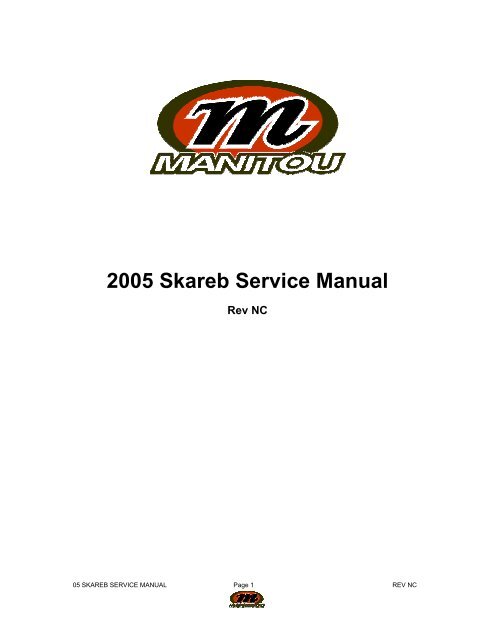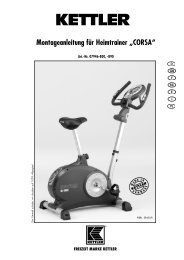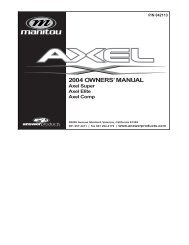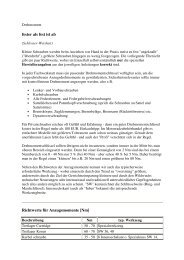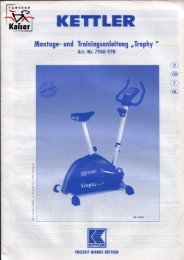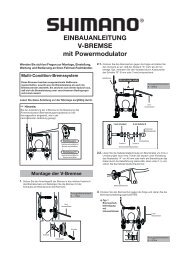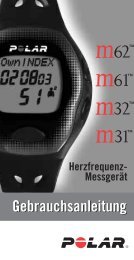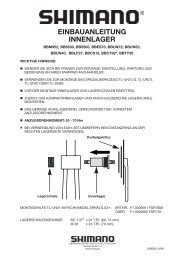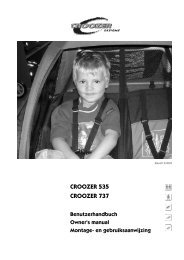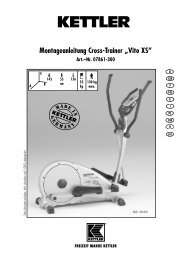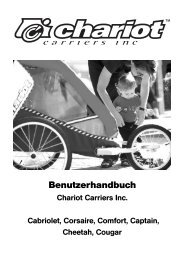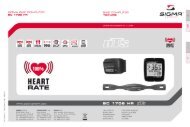2005 Skareb Service Manual - Fahrrad Kaiser GmbH
2005 Skareb Service Manual - Fahrrad Kaiser GmbH
2005 Skareb Service Manual - Fahrrad Kaiser GmbH
Create successful ePaper yourself
Turn your PDF publications into a flip-book with our unique Google optimized e-Paper software.
<strong>2005</strong> <strong>Skareb</strong> <strong>Service</strong> <strong>Manual</strong><br />
Rev NC<br />
05 SKAREB SERVICE MANUAL Page 1 REV NC
Table of Contents<br />
Description Page<br />
Introduction 3<br />
Front Suspension Terminology 4<br />
Disassembly/ Assembly Instructions 8<br />
Lock Out Troubleshooting 14<br />
Remote Lockout <strong>Service</strong> Instructions 15<br />
Infinite Travel Adjustment System (IT) Instructions 17<br />
Bushing Removal and Installation Instructions 22<br />
Troubleshooting Chart 26<br />
<strong>Skareb</strong>: Schematic and Technical Specifications 28<br />
<strong>Skareb</strong> <strong>Service</strong> Kit Chart 29<br />
Contact Information<br />
Answer Products Customer <strong>Service</strong> Department<br />
28209 Ave. Stanford<br />
Valencia, CA 91355<br />
Toll Free: (800) 423-0273<br />
Direct: (661) 257-4411<br />
FAX: (661) 775-1798<br />
E-mail: warranty@answerproducts.com<br />
tech@answerproducts.com<br />
Web site: www.answerproducts.com<br />
05 SKAREB SERVICE MANUAL Page 2 REV NC
INTRODUCTION<br />
This manual is intended to guide the user through basic service of Manitou <strong>Skareb</strong> front forks.<br />
<strong>Service</strong> is supported by the identification of common parts and assemblies that have been<br />
assembled into <strong>Service</strong> Kits. The purpose of this manual will be to describe conditions that may<br />
drive the need for service and to provide installation instructions for the kits.<br />
Due to the time-consuming nature of suspension fork service, at this time our primary focus is to<br />
offer service kits that minimize the amount of downtime and labor involved.<br />
Important information is highlighted in this manual by the following notations:<br />
WARNING<br />
Failure to follow WARNING instructions could result in severe injury or death to the<br />
person inspecting or repairing the suspension fork or the user.<br />
CAUTION<br />
A CAUTION a caution indicates special precautions that must be taken to avoid damage to<br />
the product.<br />
NOTE<br />
A NOTE provides key information to make procedures easier or clearer<br />
GENERAL WARNING: Suspension forks by design contain gases and fluids under extreme<br />
pressure and warnings contained in this manual must be observed to reduce the<br />
possibility of injury or possible death. Following these instructions can help you reduce<br />
the risk of being injured. Any questions in regards to the information in this manual<br />
should be directed to Answer Products Customer <strong>Service</strong> at (661) 257-4411.<br />
WARNING Suspension forks use compressed air to provide fluid pressure in the damping<br />
system and spring resistance in Air models. BOTH systems must be relieved of pressure<br />
prior to servicing these systems. Failure to relieve air pressure could result in injury or<br />
possible death.<br />
CAUTION: The <strong>Skareb</strong> suspension fork uses precision machined aluminum and other soft<br />
alloy components. Using correct tools for assembly is essential to prevent damage.<br />
05 SKAREB SERVICE MANUAL Page 3 REV NC
FRONT SUSPENSION TERMINOLOGY<br />
Air Cap – Top cap that threads into top of air/spring leg (this is the left leg of the fork as you are<br />
seated on the seat). Forks may be controlled with an air/spring or a coil spring. The air cap<br />
contains the Schrader Valve, which is used to control the spring rate or SAG of air forks.<br />
Air Spring – A mechanism that is used to control the SAG of an air fork.<br />
Arch – A support that connects the two outer lower legs of the casting so as to keep them moving<br />
in unison.<br />
Black Nitrate Leg Coating – New coating for steel stanchion legs that reduces stiction.<br />
Boss – The word used to describe an outer casting that has brake posts for V-brakes or<br />
cantilever brakes.<br />
Bottom Out Bumper – A rubber or elastomer device that absorbs the shock that occurs when a<br />
suspension is compression to its limit.<br />
Bushings – A cylindrical sleeve between a fork stanchion tube (inner leg) and a fork outer<br />
casting (slider), which facilitates the sliding movement between these two parts.<br />
Coil Spring Air Assist – A new feature for <strong>2005</strong> that utilizes a full length coil spring and allows<br />
you to increase the spring rate of the fork by adding air as a booster to that coil spring.<br />
Coil Spring – A coiled piece of metal that acts as a spring to help suspend a fork.<br />
Compression – The phase of the suspension operation in which the wheel travels up, or travels<br />
closer to the frame. The suspension forks reaction to a bump in the trail.<br />
Compression Damping – Restriction of the rate that the suspension compresses under load.<br />
Convertible Travel – A system used to alter the travel of a suspension fork. It requires moving a<br />
travel clip on the compression rod to a different position. This operation is accomplished by<br />
disassembling the fork and physically moving the travel clip on the compression rod.<br />
Crown Steerer Assembly – the stanchion legs (inner legs), the fork crown, and the steer tube<br />
pressed together as one assembly. This assembly is then finished by adding all of the fork<br />
internals and then outer casting (slider).<br />
Damping – A function that modifies the rate of suspension compression or rebound.<br />
Detent – An indentation that causes a rotating adjuster to stop at fixed increments.<br />
Drop Out – The end of an outer casting (slider) where the wheel attaches.<br />
Dust Boot – Usually a piece of rubber in the shape of a cylinder with baffles to allow it to<br />
compress as the fork compresses through its travel. Its function is to help keep dirt and water<br />
from getting into the inner legs of the fork.<br />
FFD – Fluid Flow Damping. A Manitou patented low cost oil damping system. The compression<br />
damping is non-adjustable and the rebound damping may be non-adjustable or adjustable<br />
damping.<br />
Fork Crown – The component that joins the stanchion tubes (inner legs) to the steer tube of the<br />
fork.<br />
05 SKAREB SERVICE MANUAL Page 4 REV NC
FRONT SUSPENSION TERMINOLOGY (CONT.)<br />
Hydraulic Fork Oil – Oil used in suspension designs to provide damping. It has special<br />
characteristics that determine how it reacts when exposed to compressed air, how it changes<br />
viscosity when its temperature changes, and how it moves through valves.<br />
Hydraulic Lock Out – a condition caused when the mixture of air and damping oil is out of<br />
balance. It is caused when there is too little air space in a chamber, not allowing the fork to<br />
compress through its travel.<br />
Infinite Travel System (IT) – A handle-bar mounted air travel adjust system that allows the rider<br />
to change the fork travel (and ride height) without a spring rate change. The travel can be<br />
changed from full compression to full rebound and at any place in between.<br />
Lock Out – a special function that restricts the compression of the fork from moving. It is<br />
generally controlled by an external knob that is activated when a rider does not want the fork to<br />
move, thus eliminating extra energy needed to overcome the bobbing forces of the fork.<br />
MCU – (Micro-Cellular Urethane) Special urethane that is filled with tiny air cells that act like<br />
springs when the elastomer is compressed.<br />
Micro Lube – Lubrication system that is operated by injecting small quantities of grease directly<br />
into ports that are inserted into outer casting legs. This enables the lubrication of the fork without<br />
having to disassemble it.<br />
No Boss - The word used to describe an outer casting that has no brake posts for V-brakes or<br />
cantilever brakes. This casting is to be used for disk brakes only.<br />
Oil Damping – A system that uses the resistance to oil flow through holes in a valve to provide a<br />
means to alter the rate of suspension compression or rebound.<br />
Oil Level – The level of damping oil needed for the optimal damping performance of a<br />
suspension. It is measured as the air space distance between the top of the stanchion leg (inner<br />
leg) and the height of the oil inside of the leg. The fork must be completely extended in order to<br />
get an accurate measurement.<br />
O-Ring – A soft, flexible neoprene or Buna rubber ring with a round cross-section, which is used<br />
for sealing and retention.<br />
Oil Weight – A description of the relative viscosity of oil, such as hydraulic oil. Oil with low weight<br />
numbers (5wt or 7wt) flows through the valving with less resistance than higher weight numbers<br />
(10or 15 wt).<br />
One Point Five Standard - 1.5 inch interface standard for frame head tubes, headset, cups,<br />
stem, and steer tubes which allows for the lightest weight and strongest design in 170mm single<br />
crown forks. This design greatly improves the control and steering precision of the fork. It is used<br />
predominately on forks with longer travel and the intended use is for more hardcore, extreme<br />
riding.<br />
Outer Casting – (see Slider)<br />
Preload – A condition of compressing a spring or elastomer before the operating loads are put on<br />
the suspension, so that it provides a stiffer spring rate.<br />
05 SKAREB SERVICE MANUAL Page 5 REV NC
FRONT SUSPENSION TERMINOLOGY (CONT.)<br />
Piston – In front suspension, the part of the damper that slides back and forth inside of the<br />
damping leg that houses the valves. It can also refer to the air piston in the air/spring assembly<br />
that slides back and forth compressing the air, thus causing a change in the spring rate of the<br />
suspension.<br />
Porosity – The condition or property of having pores in a material that will allow gas or liquid to<br />
pass through it.<br />
Platform Plus Damping – A new damping system found on <strong>2005</strong> Rear shocks (featured on<br />
Metel and Radium’s). This system will establish a pedaling efficiency platform similar to SPV, but<br />
is done through unique valving that is not adjustable (helps in bump control).<br />
Rapid Travel II, Wind Down – Systems that are used to control the travel of suspension forks.<br />
Also known as RTII, and WD. RTII is used for the specific purposes of controlling the travel in two<br />
conditions: climbing and descending. WD is an incremental travel adjustment between to set<br />
limits and does not affect the spring rate of the fork as severely as RTII.<br />
Quad Ring seal – New seal that replaces standard o-rings in designs that require more efficient<br />
air and oil sealing methods.<br />
Rebound – The phase of the suspension operation in which the wheel returns to its original<br />
position on the ground after compression.<br />
Rebound Damping – Restriction of the rate that the suspension rebounds when the compression<br />
load is relived.<br />
Remote Lock out system – A handle-bar lever actuated system that controls the lock out<br />
function on front and rear suspension products.<br />
Reverse Arch Technology – Also known as RA. It is a system that is designed to move the arch<br />
of a fork to the backside of a fork, rather than the conventional front position. It was designed to<br />
provide greater rotational torque strength to an outer casting (slider), without adding additional<br />
weight to the fork.<br />
Sag – The amount a suspension fork compresses at rest with a normal load (rider’s weight).<br />
Schrader Valve – Valve used to introduce air into a chamber.<br />
Seal – A part, usually neoprene rubber or Buna, that keeps contaminants out and/or working<br />
fluids in.<br />
Semi Bath – A lubrication system that uses a lubricating oil to keep the bushing surface and<br />
stanchion legs (inner legs) as friction free as possible during movement of the stanchion legs.<br />
Spring Rate – The rate at which the resistance of a spring increases as it is compressed.<br />
SPV – (Stable Platform Valve) new damping system that allows the rider to set the pedaling<br />
platform that he desires to pedal most efficiently in all situations. It is dependent on the pressure<br />
that the SPV valve experiences from the movement of the wheel vs. the terrain and the platform<br />
that is set by pressure introduced to other side of the SPV valve through changes of air pressure<br />
working on the damping oil.<br />
SPV Evolve – The latest version of SPV damping technology that has increased its performance<br />
with modifications to the original design.<br />
05 SKAREB SERVICE MANUAL Page 6 REV NC
FRONT SUSPENSION TERMINOLOGY (CONT.)<br />
Slider/Outer Casting – The tube (outer casting leg) of the suspension fork that0. remains fixed to<br />
the wheel. It slides up and down on the stanchion leg (inner leg).<br />
Stanchion Clamps - (Double-Triple Clamps) the portions of the fork crown that clamp around the<br />
stanchion legs above and below the head tube of the bicycle frame on specific long travel<br />
applications.<br />
Stanchion Legs – The suspension tube (inner leg) fixed to the fork crown. It remains stationary<br />
during the operation of the suspension.<br />
Steer Tube – The long cylindrical tube that extends from the top of the fork crown. Its function is<br />
to be inserted into the bicycle head tube and attach the suspension to the bicycle frame.<br />
Thru Axle – (Hex-lock) A device used for mounting a thru axle hub to special outer legs that are<br />
not made for standard quick release hubs. Manitou’s Hex-lock (thru axle) system is a special<br />
patented system utilizing a hex shaped end that increases the stiffness of the fork and reduces<br />
slippage in the joint between the axle clamps and the axle.<br />
Top Out Bumper – A rubber, coil spring, or elastomer device that absorbs the shock that occurs<br />
when the load is taken off a suspension so that it is allowed to rebound to its limits<br />
TPC – (Twin Piston Chamber) a patented damping system that has independent pistons for<br />
rebound and compression. The system utilizes a mixture of air and oil in the damping leg of the<br />
fork to enhance the damping performance.<br />
TPC+ - A variation of TPC that has added a floating piston to the compression damper to<br />
enhance the performance of the compression damping under the load of bigger hits.<br />
Travel – The amount that a wheel moves between the most compressed and the most extended<br />
states of the suspension<br />
Viscosity – A description of how a liquid flows. Liquids with higher viscosity are thicker flow less<br />
easily or quickly than liquids with low viscosity. This has an affect on the damping speeds of<br />
rebound and compression.<br />
Volume Control – A new system designed to work with SPV as a control of the compression<br />
ramp up rate of the fork. It has a range of adjustments from linear to very progressive.<br />
Wiper Seal – A rubber material that is used as a seal to keep dirt and water out of the outer<br />
casting legs. It is not designed to keep air pressure or extreme oil pressure in. Manitou has the<br />
new Evil Genius wiper seals.<br />
05 SKAREB SERVICE MANUAL Page 7 REV NC
2004 <strong>Skareb</strong> Forks Disassembly and Rebuild Instructions<br />
Removal of Outer Casting<br />
Disassembly Instructions<br />
1. From the left leg dropout (Left when sitting on the bike), use a 4mm hex wrench to<br />
remove the compression rod screw.<br />
2. From the right leg dropout, if the fork has adjustable rebound, the knob will need to be<br />
removed. Remove the 2mm hex screw inside the knob and remove the knob.<br />
3. Use a 8mm hex wrench to turn the damper clockwise until it can be pushed into the<br />
casting.<br />
4. Remove crown/steer/inner leg assembly from the outer leg casting.<br />
5. Position the bottom of the fork legs over a drain pan that is on the ground. Pull the<br />
casting downward towards the pan, allowing the Semi Bath oil in the casting to drip into<br />
the pan. Pull the casting completely off of the inner legs and wipe any excess oil off of<br />
inner legs and inside of casting.<br />
Bushing Removal & Installation<br />
Please refer to section on Bushing Removal & Installation.<br />
Removal of Compression Damping Assembly<br />
Forks with FFD (non-adjustable) Damping<br />
1. Remove top leg cap (FFD Assy) on right hand side using 27mm socket.<br />
2. Pour old oil out of the top of the fork, then compress fork upside down over oil drain pan<br />
3-5 times to get oil out from under rebound piston and discard appropriately.<br />
Forks with Adjustable Compression/Lockout Damping<br />
1. Remove the 2mm fixing screw on top of the damper knob on top right side of the fork.<br />
2. Remove 2 balls and springs from inside the top cap.<br />
3. Unscrew the compression damping assembly using a 24mm socket.<br />
4. Pour old oil out of the top of the fork, then compress fork upside down over oil drain pan<br />
3-5 times to get oil out from under rebound piston and discard appropriately.<br />
Removal of SPV Compression Damping Assembly<br />
WARNING This fork uses compressed air as part of the SPV damping system and must be<br />
relieved of pressure prior to servicing. Failure to relieve air pressure could result in injury<br />
or possible death.<br />
1. If your fork has a red Schrader cap on the top right side of the fork, it is equipped with SPV<br />
damping. Remove Schrader valve dust cap from Red Hex Shaped Top Cap on the top right<br />
of the crown. Release all air pressure from the Schrader valve.<br />
2. Remove SPV Volume Control Cap (Red Hex Shaped Top Cap) from top right of the crown<br />
with a 24mm Socket. Turn fork upside down over drainage pan to empty Damping oil from<br />
the inner leg. Stroke the Damper shaft on the bottom of the inner leg 3-5 times to purge the<br />
leg of oil that is caught below the oil piston.<br />
05 SKAREB SERVICE MANUAL Page 8 REV NC
Removal of Rebound Damping Assembly<br />
1. Unscrew Damper end cap from the bottom of the right leg and then pull out the rebound<br />
damper.<br />
Removal of SPV Rebound Damping Assembly<br />
1. If your fork had a red Schrader cap on the top right side of the fork when removing the<br />
compression damper above, it is equipped with SPV damping and will have the companion<br />
SPV rebound assembly. Unscrew damper end cap from the bottom of the right leg using a<br />
24mm Open-end wrench or 8-10” Adjustable wrench and then pull out the SPV rebound<br />
assembly.<br />
2. Checking the function of the SPV valve - Visually inspect the gap between the SPV valve and<br />
the bottom of the damping piston. It should have approximately 1mm of space. The valve<br />
should also spring back to its open rested position after compressing it with your fingers. If<br />
the valve is not responsive or all the time closed, it is bad and the rebound assembly needs<br />
to be replaced.<br />
Removal of Air Piston and Compression Rod Assembly<br />
There are now two ways to remove the air piston from the inner leg.<br />
Check for 1mm gap<br />
between the blue<br />
SPV valve and the<br />
black piston<br />
1. An Air Piston Removal tool has been developed that will enable you to remove the piston<br />
without having to take the fork apart. (P/N: 85-8062).<br />
2. Without this new tool, you will need to follow the procedures in the following section.<br />
WARNING This fork uses compressed air to provide spring resistance and must be<br />
relieved of pressure prior to servicing. Failure to relieve air pressure could result in injury<br />
or possible death.<br />
1. Remove air dust cap covering the Schrader valves.<br />
a. Depress Schrader valve to release air pressure.<br />
b. Remove air cap on top of Left leg with 20mm socket.<br />
2. Remove rebound adjuster knob using a 2mm hex wrench.<br />
05 SKAREB SERVICE MANUAL Page 9 REV NC
3. From the right leg dropout, use 8mm hex wrench to turn the damper shaft clockwise until<br />
it can be pushed into the casting.<br />
4. Remove 11mm hex bolt (Compression Rod bolt) from bottom of Left leg.<br />
5. Remove crown/steer/inner leg assembly from the outer leg casting over a drain pan,<br />
because Semi Bath oil will leak out of bottom of casting once you pull the inner legs from<br />
the outer casting legs.<br />
6. Be sure to drain all Semi Bath oil out of casting before re-assembly of fork.<br />
7. Remove left leg end cap and compression rod assembly from inner left leg. Then remove<br />
spring and Air piston rod.<br />
8. Use a long narrow rod approximately 18”/458mm long and no greater than ¼”/7mm in<br />
diameter and insert it into the left inner leg from the bottom of the leg. Be sure to direct<br />
the rod through the center of the negative spring assembly that is about halfway up the<br />
inner leg. Once the rod has contacted the air piston, use a rubber mallet and tap the<br />
piston out through the top of the inner leg.<br />
Tapping Piston out<br />
with long rod<br />
Assembly Instructions<br />
Assembly of Air Piston and Compression Rod Assembly<br />
WARNING All leg caps for Damper and Spring systems must be properly tightened prior to<br />
use. Failure to do so could result in injury or possible death.<br />
1. Apply a small amount of Prep M grease onto the threads at the top of the left inner leg<br />
with your finger.<br />
2. Apply a small amount of Prep M grease around the outside diameter of the new air<br />
piston.<br />
3. Insert the air piston (metal side up) into the inner leg through the threaded area at the top<br />
of the inner leg. Use your fingers to push the piston past the threads into the leg.<br />
Air Piston is<br />
inserted into<br />
inner leg with<br />
metal side<br />
facing up<br />
05 SKAREB SERVICE MANUAL Page 10 REV NC
4. Re-install the air push rod, positive spring (that has been well greased), and compression<br />
rod assembly. Tighten per the Fastener and Torque Values section.<br />
5. Pour about 3cc of a 40wt or greater automotive oil into the top of the piston and then<br />
install the air cap assembly. Tighten the air cap assembly 30-50in/lbs.<br />
Make sure to apply a thin layer of<br />
grease to inner threads and outside of<br />
piston before installation.<br />
Pour 3 cc of oil into top of piston<br />
6. Fully extend the damper shaft and slide the rubber bumper against the inner leg end cap.<br />
Insert the crown/steer assembly into the outer legs to the upper bushing. Holding the fork<br />
horizontal, inject 16cc of 5-40wt Semi bath oil into the hole at the bottom of each outer<br />
leg (Figure 2). A syringe works well for this procedure.<br />
7. Push the outer legs past the lower bushing and reinstall the 4mm bolt and tighten 8mm<br />
damper fitting in a counterclockwise direction. Tighten per the Fastener and Torque<br />
Values section.<br />
8. Use a shock pump (p/n 85-4069) to fill the air system to the recommended levels as<br />
outlined in the Fastener and Torque Values section.<br />
Reassembly of Crown Steer/Leg Assembly<br />
WARNING All top caps for Damper and Spring systems must be properly tightened prior to<br />
use. Failure to do so could result in injury or possible death.<br />
WARNING All leg caps for Damper and Spring systems must be properly tightened prior to<br />
use. Failure to do so could result in injury or possible death.<br />
1. Grease the outside of the air piston and then apply a thin film of grease to the threads at the<br />
top of the inner leg. It is recommended to use Prep M grease (P/N: 85-0031). Push the piston<br />
into the top of the left inner leg with the metallic side of the piston facing you, using your<br />
thumb. Push the piston past the threads and then pour approximately 3-4cc’s of a 20-50wt oil<br />
(P/N: 85-0022) into the top of the piston. This oil needs to be checked about every 6-8 weeks<br />
of riding time. It will dissipate over time and then you may experience some air leakage and<br />
increased stiction in the fork movement.<br />
2. Install the air cap and tighten it to value given on fork schematic.<br />
3. Turn crown/steer/leg assembly over, so that the bottoms of the inner legs are facing you. In<br />
the same leg that you just installed the air piston and air cap into; insert the air push rod<br />
(longer end in first), then the positive spring (this is your ride kit spring) onto the short end of<br />
the push rod, then install the compression rod assembly, and tighten end cap into leg.<br />
Tighten to torque values that are listed on fork schematic.<br />
4. Now, install damping assembly into bottom of other inner leg. If your fork uses SPV damping,<br />
be sure to check the function of the SPV valve and apply a thin layer of Prep M grease onto<br />
05 SKAREB SERVICE MANUAL Page 11 REV NC
o-ring that is around the piston at top of assembly. Install the assembly and tighten end cap<br />
to specified torque value.<br />
Assembly of Compression Damping Assembly - Non-Adjustable FFD<br />
WARNING All top caps for Damper and Spring systems must be properly tightened prior to<br />
use. Failure to do so could result in injury or possible death.<br />
1. Put a little bit of Prep M grease (Ref Answer Products PN 85-0031) on o-ring found on<br />
the lower piston of the FFD assembly.<br />
2. Install the FFD Assy into the top right hand of the crown/steer using a 27mm socket.<br />
Tighten per the <strong>Skareb</strong> Schematic and Torque Specification Table.<br />
Assembly of Compression Damping Assembly - Adjustable Compression/Lockout<br />
WARNING All top caps for Damper and Spring systems must be properly tightened prior to<br />
use. Failure to do so could result in injury or possible death.<br />
1. Fill right leg with damping oil using 5wt Motorex fork oil (Ref Answer Products PN 85-<br />
0023) to the height noted in the <strong>Skareb</strong> Schematic and Torque Specification Table. Cover<br />
the opening at the top of the right leg of the crown/steer with a rag and cycle the fork six<br />
times. Recheck oil level and add/drain to meet the level requirement.<br />
2. Put a little bit of Prep M grease (Ref Answer Products PN 85-0031) on the urethane or<br />
brown rubber o-ring found on the lower piston of the Lock out assembly.<br />
3. Twist the Hex shaped aluminum shaft that sticks up from the top cap counter clockwise<br />
until it stops (the system is completely open to oil flow at this point).<br />
4. Using a motion like screwing in a screw. Twist the assy. and apply a little pressure to<br />
insert the piston part of the mechanism past the threads at the top of the inner leg. Then<br />
push the assy. into the leg until the threads on the cap intersect the threads inside the<br />
inner leg, screw the cap. Tighten per the <strong>Skareb</strong> Schematic and Torque Specification<br />
Table.<br />
5. Once the cap is tightened, twist the Hex shaped shaft clockwise until it stops (this is the<br />
locked out position). Insert the springs into opposite holes in the top cap and then place<br />
the ball bearings on top of the springs (place a little dab of grease on spring to hold ball<br />
bearing in place).<br />
6. Place the adjuster knob onto the hex shaped aluminum shaft and seat it onto the top cap<br />
and ball bearing. Position the adjuster cap so that the lever part of the cap is at the<br />
farthest point to the back of the crown.<br />
7. Insert 2mm fixing screw and tighten to secure the knob. Twist the knob counter clockwise<br />
to activate the fork suspension. Compress the fork several times to circulate the oil<br />
through the system and then activate the Lock out system by moving the lever clockwise<br />
to its stopping point at the back of the crown. The fork should have approximately 5 mm<br />
of progressive travel before it locks out.<br />
Note: This system is a combination of adjustable compression damping that becomes a lock<br />
out. It is fully active when the lever is facing all the way forward (counter clockwise) and<br />
locked out when the lever is facing all the way towards the back of the crown (clockwise).<br />
Assembly of Compression Damping Assembly - SPV<br />
WARNING All top caps for Damper and Spring systems must be properly tightened prior to<br />
use. Failure to do so could result in injury or possible death.<br />
1. Insert the Volume control assembly into the top of the right inner leg and tighten per the<br />
<strong>Skareb</strong> Schematic and Torque Specification Table. Be sure that you unscrew the red<br />
05 SKAREB SERVICE MANUAL Page 12 REV NC
16mm Hex shaped Volume control nut all of the way counterclockwise after you tighten<br />
the entire assembly into the inner leg. Use: the Manitou Volume Control Adjuster (P/N:<br />
85-3007) to do this.<br />
Installation of Outer Leg Casting<br />
WARNING When installing the outer Leg Casting to the Crown Steer Assy, Compression<br />
Rod bolts and Damper Shafts must be properly tightened prior to use. Failure to do so<br />
could result in injury or possible death.<br />
1. Turn completed crown/steer/leg assembly upside down, so that the compression rod and<br />
damper shaft are facing you. You will see a bottom out bumper on the damper shaft; slide<br />
this bumper down towards the end cap that is threaded into the inner leg. This will help in<br />
keeping the shaft extended as you install the outer casting.<br />
2. Pressurize the air spring to 100psi; this will help keep the compression rod extended as<br />
you install the outer casting.<br />
3. Press inner legs into casting about half way and then inject Semi Bath oil (5/40wt.<br />
synthetic oil, P/N: 85-0022) into outer casting, holding fork at 45 degree angle to the<br />
ground with bottom of fork in the air (drop outs up). Inject 16cc’s of oil into each outer<br />
leg. It is recommended to use a syringe to inject oil.<br />
4. Finish sliding inner leg assembly into outer leg casting until damper shaft contacts<br />
casting.<br />
5. Use an 8mm hex wrench to turn the damper shaft counterclockwise, threading it into<br />
the casting. Tighten per the <strong>Skareb</strong> Schematic and Torque Specification Table.<br />
6. Install rebound adjuster knob if applicable. Knob should turn uninhibited until the<br />
indicator is stopped by the casting. If not, remove knob and reinstall on hex shaft in 1/6<br />
turn increments until full travel is reached.<br />
7. Install the 4mm compression rod screw and tighten per the <strong>Skareb</strong> Schematic and<br />
Torque Specification Table.<br />
05 SKAREB SERVICE MANUAL Page 13 REV NC
Lock Out Troubleshooting Tips<br />
Installation of Lock out Compression Damping System<br />
• Check the o-ring that is installed around the lower piston on the damper shaft for<br />
tears or deformation. Replace it, if it is damaged. This is the most common reason<br />
why the Lock out system will not function.<br />
• Check the level of oil in the inner leg. The oil level may be a little high, but never<br />
low. The oil level must be high enough to cover the window that opens and closes on<br />
the damper shaft.<br />
• Make sure that the oil flow window on the lower portion of the damper shaft,<br />
positioned right above the piston, opens and closes when you move the lock out knob<br />
from open to close.<br />
• Inspect the rubber o-ring that is around the threaded portion of the cap that screws<br />
into the inner leg of the fork. This o-ring should not have nicks or tears in it and<br />
should fit tightly around the cap.<br />
• Make sure that when installing the Lock out system into the fork leg that you follow<br />
this procedure: Put a little bit of Prep M grease on the urethane o-ring, make sure that<br />
that the oil flow window is open using a motion like screwing in a screw. Twist the<br />
assy. and apply a little pressure to insert the piston part of the mechanism past the<br />
threads at the top of the inner leg. Then push the assy. into the leg until the threads on<br />
the cap intersect the threads inside the inner leg, screw the cap in and do not use any<br />
tools to over tighten the cap. Once the cap is tightened, compression the fork several<br />
times to circulate the oil through the system and then activate the Lock out system by<br />
moving the lever to the other position. The fork should have between 2 & 5mm of<br />
progressive travel before it locks out.<br />
1. Troubleshooting<br />
• If the Lock out does not lock out properly, go back through the steps listed above.<br />
• If the o-rings are damaged on the Lock out piston, replace them with P/N<br />
062594(urethane 1998-2003 Mars, SX, & <strong>Skareb</strong> Lock outs), 065261 (04/05<br />
<strong>Skareb</strong> Lockouts) and 02/03 Black 100/120mm Lock outs, and 040315 (Axel’s).<br />
• If the oil level is low, check to see if there is evidence of leaking at the Rebound<br />
Damper. If so, replace the Rebound Damper assembly and retry the Lock out. The oil<br />
level may be low if you are upgrading a standard Compression Damping system with<br />
the Lock out system. In this case, make sure the oil level is at the correct level before<br />
trying it again. If there are signs of oil leaking around the top of the Lock out system,<br />
check the rubber o-ring (040524) and replace if needed. If the window does not open<br />
or close when the knob is moved, replace the entire Lock out assembly.<br />
05 SKAREB SERVICE MANUAL Page 14 REV NC
Complete Remote Lock out Assembly<br />
Barrel<br />
adjuster<br />
Lever Kit and<br />
Lever cover<br />
Kit<br />
Cable<br />
Assembly<br />
Tools needed<br />
to service<br />
assembly<br />
Remote Lock out <strong>Service</strong> Instructions<br />
Cable Guide<br />
Lock out<br />
Assembly<br />
Adjustable Pliers Socket Wrench<br />
Adjustable Wrench 22mm Socket<br />
W/cut out<br />
10mm open end wrench<br />
Please continue to next page for more<br />
<strong>Service</strong> instructions<br />
There are (5) <strong>Service</strong> kits available for each fork<br />
model that utilizes a Remote Lock out.<br />
1. Lever assembly 2. Lever Cover<br />
3. Cable assembly 4. Cable guide<br />
5. Lock out assembly<br />
*Reference to these kits may be found in the<br />
<strong>Service</strong> Parts Matrix<br />
Instructions for removing assembly from fork<br />
1. Unscrew barrel adjuster in a<br />
counterclockwise direction until it stops.<br />
2. Remove Lever cover by squeezing the two<br />
plastic prongs together on the under side of<br />
the lever and pulling the cover in an upwards<br />
direction from the lever assembly.<br />
3. Pull on Black cable ferrule nearest to lever<br />
and pull cable assembly from the groove in<br />
the Lever assembly, thus releasing cable<br />
from lever. Unhook cable end from lever.<br />
4. Unscrew the top cap of the Lock out<br />
assembly from the fork crown using socket<br />
(Answer p/n: 83-2503) or an adjustable<br />
wrench.<br />
5. Pull Lock out assembly out of crown by<br />
twisting the assembly like unscrewing a<br />
screw and applying an upward pressure.<br />
Slowly pull assembly out of crown and watch<br />
out for some excess damping oil to come out<br />
of inner leg as the piston at the end of the<br />
assembly comes out of crown.<br />
05 SKAREB SERVICE MANUAL Page 15 REV NC
Step 1<br />
Step 2<br />
Tool Placement to unscrew upper<br />
shaft assembly from lower<br />
assembly (Figure A)<br />
Cable hook up connection<br />
(Figure B)<br />
Figure C<br />
Steps of Cable Disassembly<br />
Step 3<br />
Cable Replacement Instructions<br />
1. Step 1: Lock out assembly should be out of fork at<br />
this point.<br />
2. Step 2: Cable assembly should be out of Lever<br />
assembly<br />
3. Step 3: Look at tool placement in Figure A. It is<br />
recommended to use the Adjustable Pliers to grasp<br />
the flange of the lower assembly right above the coil<br />
blow off spring. Use a 10mm open end wrench on<br />
the flats of the upper assembly just below the top<br />
cap. Hold the flange with the Pliers and turn the<br />
10mm wrench in a counterclockwise direction in<br />
order to unscrew the upper and lower assemblies.<br />
4. Separate the two assemblies and unhook the cable<br />
end from the eye hook as shown in Figure B.<br />
5. Pull the cable out through the top cap and red cable<br />
guide. There will also be a 75mm spring inside of<br />
the upper shaft. This spring provides the tension for<br />
the cable when you move the Lock out lever from<br />
the Lock position to Unlock position. The inner<br />
cable runs through the center of the spring.<br />
Cable Installation Instructions<br />
1. The inner cable is not removable from the cable<br />
assembly. The entire cable assembly must be<br />
replaced. Install the new cable assembly by<br />
reversing the Disassembly the instructions.<br />
2. Slide the inner cable through the red cable guide,<br />
the top cap, and down through the spring. (Be sure to<br />
put a little bit of the Prep M grease on the spring<br />
before putting it back into the upper shaft assembly.)<br />
3. Push the cable assembly together, forcing the inner<br />
cable to stick through the spring and then out<br />
through the end of the upper shaft assembly. (See<br />
Figure C). Hook the cable end into the eye hook and<br />
then pull on the cable assembly to pull the two shafts<br />
together. Tighten them together snuggly.<br />
4. Check oil level in fork leg (refer to oil level heights<br />
in fork spec sheets). Install Lock out assembly into<br />
the fork leg and tighten top cap to proper torque.<br />
5. Re-install the other cable end into the Lever<br />
assembly, and then put the lever cover back on to the<br />
Lever assembly. You may have to pull the cable<br />
assembly away from the housing of the lever<br />
assembly to expose the inner cable, so that you can<br />
slide the cover into its proper position.<br />
05 SKAREB SERVICE MANUAL Page 16 REV NC
IT System Disassembly Instructions<br />
1. Remove front wheel and brake set from fork.<br />
2. Important: you must remove all of the air from<br />
the left leg of the fork before disassembling the IT<br />
System. There may also be a discharge of a white<br />
substance when you depress the Schrader valve<br />
core (this is similar to the discharge when you<br />
depress the valve core on any of the Manitou Air<br />
or SPV forks).<br />
3. On the bottom of the left leg (leg that has the Disk<br />
Brakes mounts on it), there is a Schrader valve<br />
protruding from it. Unscrew the valve cap and<br />
follow either of these two methods for releasing<br />
all of the air from the system.<br />
A. Depress the valve core and let all of the<br />
air out. Now depress the IT lever on the<br />
bike’s handlebar and release it. Once<br />
again, depress valve core in the<br />
Schrader valve to release any air in the<br />
leg. Do this a couple of times, until all<br />
of the air is released.<br />
B. If you have a helper, have them hold the<br />
IT lever on the handlebar down as you<br />
depress the valve core. This will let all<br />
of the air out at one time.<br />
4. Now that all of the air is released, unscrew the<br />
12mm nut that is threaded onto the Schrader<br />
valve. It is recommended to either turn the fork<br />
upside down or hold it right side up over a drain<br />
pan to catch the Semi Bath lubrication oil that will<br />
come out of the bottom of the casting as you start<br />
the procedure of removing the casting. (see Fig 1)<br />
5. Move over to the bottom of the right leg and<br />
unscrew the 2mm Allen screw from the middle of<br />
the rebound adjuster knob. Pull the knob away<br />
from the bottom of the casting leg exposing a<br />
recessed 8mm hex.<br />
6. Use an 8mm Allen Wrench and turn it in a<br />
clockwise direction in order to unscrew the<br />
rebound damper shaft from the casting.<br />
7. You can now remove the casting, exposing the<br />
fork’s inner legs. Be aware that there may be<br />
some of the Semi Bath oil in the casting after you<br />
remove it.<br />
8. Use an Adjustable Wrench and unscrew the black<br />
end cap that is threaded into the bottom of the left<br />
inner leg.<br />
9. Pull the lower IT assembly from the inner leg.<br />
There may be a very little amount of oil that<br />
comes out of the inner leg as you remove the<br />
lower IT assembly. This is the lubricating oil used<br />
to allow the air piston on the lower shaft assembly<br />
to move freely.<br />
Infinite Travel System<br />
(IT)<br />
Lower<br />
Assembly<br />
IT Lever<br />
Assembly<br />
Valve<br />
Core Tool<br />
Air Piston<br />
22mm slotted socket<br />
Upper<br />
Assembly<br />
IT System Components<br />
<strong>Service</strong> Tools Needed<br />
05 SKAREB SERVICE MANUAL Page 17 REV NC<br />
Top Cap &<br />
Cable Guide<br />
Inner & Outer<br />
IT control wire<br />
Adjustable Wrench<br />
12mm<br />
Wrench
Disassembly Instructions continued<br />
10. Now it is time to remove the IT upper assembly.<br />
Release the IT control wire from the control lever by<br />
unscrewing the fixing screw on the lever that holds the<br />
cable tight. Use a 2mm Allen Wrench to unscrew this<br />
screw and then pull the cable out of the lever. (Go to<br />
Fig 2 for next step)<br />
11. To remove the upper IT assembly, use a slotted 22mm 6<br />
point socket (P/N: 83-2503), a 22mm Open End<br />
wrench, or an adjustable wrench.<br />
(Note: Be aware of the IT control Wire spinning<br />
around when unscrewing the top cap)<br />
12. Pull the upper assembly out of the inner leg.<br />
Troubleshooting Tips<br />
1. Here is a guide to help pinpoint fork travel issues.<br />
** If the fork starts to lose travel from an<br />
extended position to a shorter position by itself,<br />
the damage is most likely centered on the Quad<br />
ring around the outside of the piston.<br />
**If the fork extends from a shorter travel to a<br />
longer travel by itself, the failure can be involving<br />
the smaller Quad ring that is located under the<br />
piston on the inside diameter of it where the shaft<br />
of the upper assembly intersects the lower<br />
assembly and piston. The shaft is sealed against<br />
leakage at this point to define the two different<br />
chambers.<br />
A. Always check two things when you have the<br />
system apart.<br />
***Use a straight edge and lay it next to the inner<br />
shaft that is attached to the top cap of the upper<br />
assembly to insure that that shaft is not bowed at<br />
any point. We found that on assembly of these<br />
pieces, the shaft is pressed into the top cap and if<br />
it is over pressed, the shaft will bow. This means<br />
that at where the bow is in the travel of the shaft,<br />
it will cause the Quad ring that it is passing<br />
through, to distort. Thus air transfers from one<br />
chamber to the other and the fork will extend by<br />
itself. If this is the case, you will need a new top<br />
assembly and an O-ring kit. (Refer to Figure 3)<br />
***Make sure that the valve core in the Schrader<br />
valve is tight and does not stick open or closed. If<br />
this is faulty, replace this valve core with a new<br />
one. Any bicycle tube valve core will work, as<br />
well as any valve cores that we currently use on<br />
any of our other products.<br />
B. On the lower assembly, inspect the Quad ring<br />
that is around the piston at the top of the lower<br />
assembly. You are looking to see if it is seated<br />
properly and not torn or twisted. Also inspect the<br />
piston to see if there are unusual wear marks on<br />
the piston on one side of the piston only.<br />
If this is a wear spot, then this means that the hole<br />
in the bottom of the casting is slightly off center<br />
and the casting needs to be replaced with a new<br />
one. (Refer to Figure 4)<br />
(Continued on next page)<br />
Figure 1<br />
Figure 2<br />
Figure 3<br />
Figure 4<br />
05 SKAREB SERVICE MANUAL Page 18 REV NC
Troubleshooting Tips continued<br />
This condition causes the Lower shaft assembly to<br />
be side loaded inside of the inner leg and causes<br />
wearing of the piston that allows for a poor fit of<br />
the Quad ring and thus an air leak<br />
C. The last item to be concerned with is the<br />
casting. When reassembling the fork, be sure to<br />
visually inspect the position of the bottom of the<br />
lower assembly as it begins to come through the<br />
bottom hole in the casting before you secure it<br />
with the 12mm nut.<br />
If that shaft is not guiding itself straight through<br />
that lower hole without any assistance, you will<br />
eventually see the same issue as mentioned above.<br />
Once again it is a casting issue.<br />
(Note: Always replace all o-rings and seals<br />
provided in the IT O-ring kit, each time you<br />
take the system apart)<br />
IT Control Wire Change<br />
1. In order to change the inner control wire, start by<br />
following IT disassembly steps 2, 3, 10, 11, & 12.<br />
2. Once you have the upper assembly out of the fork, use<br />
the adjustable wrench and the 12mm Open End wrench<br />
to unscrew the top cap from the shaft of the assembly.<br />
Refer to Figure 5 at the right.<br />
3. As you unscrew the top cap, you will feel a little tension<br />
created by a spring that is under the cap. Separate the top<br />
cap from the shaft once you have completely unthreaded<br />
the two pieces.<br />
4. Pull on the inner wire in order to remove the machined<br />
stopper with the cable end in it from the shaft.<br />
5. You can now unhook the cable from the stopper and<br />
from the cable head end, pull the cable through the<br />
spring, the top cap, and the outer cable housing. Refer to<br />
Figure 6 at the right.<br />
6. Reverse the above steps to replace the cable.<br />
(Note: The inner cable can be replaced with a<br />
standard bicycle Derailleur cable)<br />
(It is recommended to replace the two O-rings on the<br />
stopper each time that it is removed from the shaft,<br />
in addition to the Black Buna O-ring that is on the<br />
shaft below the threads.)<br />
7. Tighten top cap on the shaft to 25inlbs (2.85Nm).<br />
8. Put a small amount of Motorex grease on the end of the<br />
Upper Assembly shaft, and then insert the assembly into<br />
the fork inner leg.<br />
9. As soon as contact is made with the hole in the top of<br />
the air piston/lower assembly, twist the upper assembly<br />
like screwing in a screw to guide the upper assembly<br />
shaft into the hole without damaging the Quad ring seal<br />
in the shaft of the lower assembly.<br />
10. After reinserting the upper assembly into the fork but<br />
before screwing the top cap in, pour about 6-8cc’s of<br />
40wt. automotive oil into the fork leg through the top of<br />
the crown.<br />
Figure 5<br />
Top Cap Spring Machined Stopper<br />
Figure 6<br />
05 SKAREB SERVICE MANUAL Page 19 REV NC<br />
Shaft with Buna O-ring
11. Feed the inner wire through the cable housing and<br />
secure one end of the of the housing into the gold<br />
cable guide, then feed the end of the inner wire<br />
through the hole in the black cable stop on the<br />
lever.<br />
12. The inner wire now feeds through the hole in<br />
bottom of the lever, over the top of the lever and<br />
through the hole in the back of the lever.<br />
13. Pull the inner wire until there is no slack in the<br />
cable. Be sure to set a 2mm gap between the front<br />
of the lever and the top of the cable stop to insure<br />
that you have not Figure over tightened 7 the cable 2mm before gap<br />
you tighten the 2mm Allen bolt on the front of the<br />
lever to cinch the inner wire. (Refer to Figure 7)<br />
14. The last step is to cut the inner wire that is left<br />
hanging on the backside of the lever and then<br />
installing the cable end to prevent it from fraying.<br />
Replacement of Piston Quad Rings<br />
1. In order to replace the Air piston Quad rings, you<br />
need a 12mm Open End wrench and an adjustable<br />
wrench.<br />
2. Refer to Figure 8 for wrench placement. Hold the<br />
12mm wrench in place on the flats that are on the<br />
piston seat and turn the piston with the adjustable<br />
wrench in a counter clockwise motion to unscrew<br />
the piston from the shaft.<br />
3. Once the piston is off of the shaft, you will see a<br />
small Black Quad ring inside the top of the shaft<br />
that you just unscrewed the piston from. Use a<br />
small diameter object to remove the Quad ring<br />
from the shaft. Replace this Quad ring with a new<br />
one from your IT O-ring kit. Be sure that it is<br />
seated in the shaft and rests flat against the shelf<br />
inside of the shaft. (Refer to Figure 9)<br />
4. Install the Air Piston back onto the shaft in the<br />
reverse of the way you removed it. Tighten the<br />
piston to 15inlbs (1.7Nm) onto the shaft.<br />
5. To remove the large Quad ring on the outside of<br />
the piston, grasp the piston at the Quad ring like<br />
you would pinch someone with your thumb and<br />
pointer finger. Squeeze the Quad ring and you<br />
will see a section of the Quad ring move away<br />
from the piston. Use the same tool that you used<br />
to remove the small Quad ring from the shaft and<br />
pry the Quad ring off of the piston, being careful<br />
not to scar the surfaces of the piston.<br />
6. Discard this Quad ring and replace it with a new<br />
one. Be careful not to twist it in the seat that it<br />
rests in.<br />
7. You are now ready to reassemble the IT system.<br />
Note: Always change all Quad rings and orings<br />
when servicing the IT system<br />
Figure 7<br />
Figure 8<br />
Figure 9<br />
05 SKAREB SERVICE MANUAL Page 20 REV NC<br />
2mm<br />
Gap
Reassembly of the IT System<br />
1. It is recommended that when reassembling the<br />
IT system that you start by installing the lower<br />
assembly into the bottom of the inner leg first.<br />
Be sure to apply a small amount of Prep M<br />
grease to the Quad ring on the outside of the<br />
piston and onto the threads of the inner leg<br />
before inserting assembling into leg.<br />
2. Twist shaft assembly as you insert piston past<br />
the threads of inner leg. Tighten end cap to 25-<br />
35inlbs (2.8-3.9Nm).<br />
3. Refer to steps 8, 9, and 10 above in the “IT<br />
Control Wire Change” for installation of the top<br />
assembly.<br />
4. Once this assembly is installed; the casting can<br />
be installed, Semi Bath oil added, and all<br />
fasteners secured.<br />
5. When re-inflating the IT system, it is fastest if<br />
you have someone depress the control lever and<br />
hold it while you pump air into the system. This<br />
way the system equalizes immediately. If you<br />
do not have a second person to help, just add air<br />
to the system and then periodically depress the<br />
lever to equalize the pressure. This may have to<br />
be done a couple of times in order to reach the<br />
required air pressure.<br />
6. It is recommended to initially set your fork up<br />
with an air pressure that is approximately 75%<br />
of your rider weight. Then you can fine tune<br />
your ride by adding or deleting air as you need.<br />
Lower<br />
Assembly<br />
IT <strong>Service</strong> Kits<br />
Lever Kit<br />
Assembly<br />
Cable<br />
Guide<br />
Top Assembly<br />
05 SKAREB SERVICE MANUAL Page 21 REV NC
Bushing Removal & Installation<br />
Bushing Removal<br />
(Note: use appropriate removal ring that corresponds to the leg diameter of the fork being<br />
repaired)<br />
Leg Diameter Answer Kit #<br />
25.4mm (1”) 85-5191<br />
28.6mm (11/8”) 85-5189<br />
30mm 85-5194<br />
32mm 85-5192<br />
Bushing Removal Tool Components<br />
A. Slide Hammer<br />
B. Threaded Handle<br />
C. Slide<br />
D. Threaded Shaft<br />
E. Removal Ring<br />
Bushing Removal Tool Assembly<br />
05 SKAREB SERVICE MANUAL Page 22 REV NC
Bushing Removal Instructions<br />
A. Install 25.4mm Removal ring on the<br />
shiny, smaller diameter threaded shaft.<br />
Be sure to install the ring with the<br />
tapered, chamfered end first, followed by<br />
the long slide tube. This tapered end<br />
leads the tool through the bushing.<br />
B. Start the procedure by removing the<br />
Dust/Wiper seal with a screwdriver,<br />
prying it out.<br />
C. Insert Removal tool past the upper<br />
bushing and then stop. It is important to<br />
pull one bushing out at a time. Push the<br />
slide on the threaded shaft down<br />
towards the removal ring. Hold the<br />
casting with one hand and the slide<br />
hammer with your other hand. Now<br />
move the slide hammer in a motion away<br />
from the casting and repeat this action<br />
until the bushing comes out.<br />
D. For all other leg diameters: use the<br />
larger diameter (dark colored) threaded<br />
shaft and repeat steps A-C.<br />
Bushing Removal (CONT.)<br />
Bushing Installation<br />
(Note: Sizer kits listed in above chart contain the sizers needed for each specific leg diameter.)<br />
Bushing Installation Tool Components<br />
1. Installation Mandrel<br />
2. Threaded Rod w/nuts<br />
3. Sizer rings<br />
4. Spacer<br />
5. Washer<br />
6. Nut<br />
(1) (2)<br />
(3) (4) (3) (5) (6)<br />
05 SKAREB SERVICE MANUAL Page 23 REV NC
Bushing Installation Tool Assembly<br />
With weighted handle<br />
When selecting sizer rings to install bushings,<br />
choose the two rings that are in the middle of<br />
the size run to start with.<br />
1. Assemble installation tool as shown in<br />
picture above. Each leg diameter kit has all<br />
of the needed pieces to remove and install<br />
bushings for forks with serviceable<br />
bushings. Some of the kits come with<br />
gauges to tell you how far to drive in the<br />
lower bushings. Upper bushings are driven<br />
in as far as the stop in the top of the<br />
casting will allow. The general rule of<br />
thumb is that the lower bushings must not<br />
be driven any deeper than 5” into a casting<br />
leg. If they do go deeper, call Customer<br />
<strong>Service</strong> at Answer Products – 800-423-<br />
0273 for a new outer casting.<br />
2. Always assemble Mandrel with the larger<br />
diameter sizer ring being placed on the<br />
mandrel first, then the spacer, the next<br />
largest sizer ring, followed by the washer<br />
and the nut to hold it in place. Be sure to<br />
lock the nut above the Mandrel and below<br />
the Mandrel against each other.<br />
3. Replace the lower bushing (bushing with a<br />
thicker wall diameter) first. Place a small<br />
amount of Prep M grease onto the sizer<br />
rings to help the rings come through the<br />
bushings when pulling them out. Slide<br />
bushing onto Mandrel until it stops. Apply<br />
a bead of Red Loctite all the way around<br />
the outside of the bushing. Hold casting on<br />
top of bench with a rag under the end of<br />
the legs and insert installation tool with<br />
bushing into casting leg.<br />
Bushing Installation (CONT.)<br />
05 SKAREB SERVICE MANUAL Page 24 REV NC
Bushing Installation (CONT.)<br />
4. Slide weighted handle onto end of threaded rod and tap rod into casting with rubber Mallet<br />
until proper depth is achieved. If using depth gage, slide gage onto rod before installing<br />
weighted handle and let it settle on of Mandrel. Tap rod until appropriate line on gage is even<br />
with top of casting leg.<br />
5. Remove weighted handle and gage (if applicable).<br />
6. For sizing of the lower bushing:<br />
7. Use slotted top cap from sizer kit and set it into the top of the casting leg, straddling the<br />
threaded rod. Spin the extra nut with washer down to the top cap and using a wrench,<br />
socket, or speeder wrench, tighten the nut in a clockwise direction. This will cause the<br />
Mandrel to be pulled through the bushing, thus sizing it. Keep turning the nut until the tool is<br />
all the way through the bushing and can be pulled out of the leg.<br />
8. To install top bushings, repeat steps B-E. Note that the top bushing gets inserted until it stops<br />
against the step inside of the casting. The extra sleeve that comes with the sizer kit is used<br />
to space the top cap off of the casting, so that there is enough room to pull the sizers out of<br />
the casting without bottoming on the cap.<br />
9. If you find that the bushings are too tight after installing them, use the sizer Mandrel that does<br />
not have a stop on it to hold the bushing while installing it into the casting. This is available in<br />
the 25.4mm leg kit (85-5191) to go back in and resize the bushings.<br />
10. To resize bushings, Choose the next larger size rings and repeat the above process.<br />
11. When satisfied with the results, reinstall Dust/wiper seals and then reassemble fork<br />
05 SKAREB SERVICE MANUAL Page 25 REV NC
TROUBLESHOOTING<br />
Symptom Cause Solution<br />
Air Loss Schrader Valve leaks<br />
Air Cap O-ring leaks<br />
Air Piston leaks<br />
Air Top Cap leaks<br />
Oil leaks from<br />
Wiper Seals Seal not seated properly<br />
Oil leaks from<br />
bottom of<br />
Casting<br />
Nicks or scratches on<br />
inner legs<br />
Too much Semi Bath oil<br />
Wear<br />
Tighten Valve core, replace bad parts as<br />
needed. 10<br />
Make sure O-ring is seated properly,<br />
replace parts as needed. 9<br />
Check oil volume on top of piston, replace<br />
parts as needed. 9<br />
Check O-ring, tighten cap to proper<br />
Torque, replace parts as needed. 9<br />
Remove Casting from Inner Legs, reinstall<br />
or replace seals 8<br />
Replace Crown/Steerer/Inner Leg<br />
Assembly 8<br />
Follow instructions for removal and<br />
installation of Outer Casting 13<br />
Remove Casting from Inner Legs, reinstall<br />
or replace seals 8<br />
Rebound damper shaft<br />
leaks Replace Rebound Damping assembly 9<br />
Rebound damper shaft Oring<br />
damaged<br />
Compression Rod Bolt<br />
leaks<br />
Lack of Travel Tight Bushings<br />
Replace O-ring on threaded end of<br />
Rebound Damping assembly 9<br />
Check O-ring on bolt to see if it is<br />
damaged and then reinstall 8<br />
Resize bushings or replace with new ones<br />
if damaged 22<br />
Hydraulic lock out Replace Rebound Damping assembly 9<br />
Semi Bath oil volume<br />
Damper oil volume<br />
Fork alignment<br />
Loss of SPV<br />
damping SPV valve not functioning<br />
Damper oil volume<br />
Follow instructions for removal and<br />
installation of Outer Casting 13<br />
Check oil level, Replace Rebound<br />
Damping assembly if needed 12<br />
Visually inspect fork, call Answer<br />
Products Customer <strong>Service</strong> 2<br />
Inspect for damage, check valve gap,<br />
replace assembly if needed 8<br />
Check oil level, refer to "Oil leaks from<br />
bottom of Casting" 12<br />
Rebound knob does not<br />
turn Replace Rebound Damping Assembly 9<br />
Loss of SPV air pressure<br />
Refer to "Air Loss- Schrader valve leaks<br />
and Air Cap O-ring Leaks" 9<br />
<strong>Service</strong><br />
<strong>Manual</strong><br />
Page<br />
05 SKAREB SERVICE MANUAL Page 26 REV NC
TROUBLESHOOTING (CONT.)<br />
Symptom Cause Solution<br />
Fork Top out<br />
<strong>Service</strong><br />
<strong>Manual</strong><br />
Page<br />
Loss of Rebound<br />
Damping Replace Rebound Damping assembly 9<br />
SPV Valve not functioning<br />
Top out spring damaged<br />
Damping oil volume not<br />
correct<br />
Fork Bottoms<br />
out Too much SAG<br />
Bottom out Bumper<br />
damaged<br />
Damping oil volume not<br />
correct<br />
Play in Fork Loose bushings<br />
Refer to " Loss of SPV Damping - SPV<br />
valve not functioning" 9<br />
Inspect and replace Top out spring if<br />
needed. 12<br />
Check oil level, Replace Rebound<br />
Damping assembly if needed 12<br />
Refer to SAG Set up in Tuning section of<br />
Owners <strong>Manual</strong><br />
Inspect and replace Bottom out Bumper if<br />
needed 11<br />
Check oil level, Replace Rebound<br />
Damping assembly if needed 12<br />
Resize bushings or replace with new ones<br />
if damaged 22<br />
Loose Compression Rod<br />
bolt Tighten bolt to specified torque 12<br />
Loose Rebound damping<br />
shaft Tighten Shaft to specified torque 9<br />
Loose press fit tolerances Call Answer Products Customer <strong>Service</strong> 2<br />
RLO Problems Various See Remote Lock Out section 15<br />
Lock Out<br />
Problems Various See Lock Out Section 14<br />
Infinite Travel Various See IT Section 17<br />
05 SKAREB SERVICE MANUAL Page 27 REV NC
<strong>Skareb</strong>: Schematic and Technical Specifications<br />
E<br />
Model: <strong>Skareb</strong><br />
Description Torque Values<br />
H<br />
Torque – Brake Post 90–110inlbs (10.2-12.4nm)<br />
Bushing Depth – Upper *8.9mm Min. (.35”)<br />
Bushing Depth – Lower *99 – 106 mm (3.9 - 4.2”)<br />
Air Preload Cap:<br />
Torque 50inlbs (5.7nm)<br />
Schrader Valve Torque 3-5inlbs (.34-.57nm)<br />
Leg Caps 25–35inlbs (2.8-4.0nm)<br />
Torque - Comp Rod Screw *15 – 61KgCm (13 – 53inlbs)<br />
Torque - Damper Screw *15 – 24KgCm (13 – 20inlbs)<br />
Adjuster caps & Top Caps 35-50inlbs (4.0-5.7nm)<br />
Semi Bath Oil Volume 16cc per leg<br />
Damping Oil<br />
Damping oil Level - Non SPV 110 – 120mm (4.3 – 4.7”)<br />
Damping oil Level – SPV for 80mm Travel Forks 68 – 72mm (2.7 – 2.8”)<br />
Damping oil Level - SPV for 100mm Travel Forks 73 – 77mm (2.9 – 3.0”)<br />
05 SKAREB SERVICE MANUAL Page 28 REV NC<br />
B<br />
A<br />
D<br />
C<br />
G
<strong>Skareb</strong> <strong>Service</strong> Kits<br />
Model Comp Elite Super Platinum<br />
Travel (mm) 80 100 80 100 80 100<br />
Comp Damp FFD A 85-5558 85-5559<br />
SPV Volume Adj. A 85-4467<br />
Remote L/O - Lever Left A 83-2180<br />
Remote L/O - Lever Right A 83-2402<br />
Remote L/O - Cover Left A 83-2181<br />
Remote L/O - Cover Right A 83-2403<br />
Remote L/O - L/O A 83-2404<br />
Remote L/O - Cable A 83-2182<br />
Remote L/O - Cable Guide A 83-2183<br />
Remote L/O - O-Ring Kit A 83-2410<br />
Rbnd Damp - Adj B<br />
85-<br />
4471<br />
85-<br />
5308<br />
85-<br />
4471<br />
85-<br />
5308<br />
SPV Rebound B 85-5587<br />
Air Cap C 85-4473<br />
Air Volume Adjust Cap C 85-5588<br />
85-<br />
4471<br />
100mm<br />
IT TA<br />
85-<br />
5308 85-5308<br />
IT Top Assy C 83-2322<br />
IT Top Cable Guide C 83-2318<br />
IT HB Lever C 83-2319<br />
Crn/Str/Leg D<br />
***Steel S/T (26")<br />
***Blk AL S/T(26") SPV<br />
***Blk AL S/T(26")<br />
STD/SM<br />
Outer Leg Assy E<br />
85-<br />
5560<br />
85-<br />
4449<br />
85-<br />
5562<br />
85-<br />
5561<br />
85-<br />
4455<br />
85-<br />
5563<br />
85-<br />
5560<br />
85-<br />
4449<br />
85-<br />
5562<br />
85-<br />
5561<br />
85-<br />
4455<br />
85-<br />
5563<br />
85-<br />
5560<br />
85-<br />
4449<br />
85-<br />
5562<br />
85-<br />
5561<br />
85-<br />
4455 83-2341<br />
85-<br />
5563 83-2340<br />
STD Black (26") 85-4470 83-2303<br />
STD Silver (26") 85-5101 83-2301<br />
STD Red (26") 85-5102<br />
STD White 85-5103<br />
STD Bike Blue 83-2293<br />
STD Cobalt 85-5260<br />
STD Orange 85-5565<br />
STD Yellow 85-5566<br />
STD Candy Chrome 85-5109<br />
STD Candy Red 85-5107<br />
STD Candy Blue 85-5108<br />
STD Matte Black 83-2295 83-2304<br />
05 SKAREB SERVICE MANUAL Page 29 REV NC
<strong>Skareb</strong> <strong>Service</strong> Kits<br />
Model Comp Elite Super Platinum<br />
Travel (mm) 80 100 80 100 80 100<br />
Outer Leg Assy (con't) E<br />
100mm<br />
IT TA<br />
NB, STD DO Black (26") 85-5111 83-2359<br />
NB, STD DO Silver (26") 85-5112 83-2302<br />
NB, STD DO Red (26") 85-5113 83-2305<br />
NB, STD DO White 85-5114<br />
NB, STD DO Bike Blue 83-2294<br />
NB, STD DO Cobalt 85-5568<br />
NB, STD DO Orange 85-5569<br />
NB, STD DO Yellow 85-5570<br />
NB, STD DO Candy Chrome 85-5120<br />
NB, STD DO Candy Red 85-5118<br />
NB, STD DO Candy Blue 85-5119<br />
NB, STD DO Matte Black 83-2296<br />
Sticker Kit F - For Dark Colors<br />
F - For Light Colors<br />
Ride Kits G<br />
Travel Adjust/ H<br />
Comp Rod/ H<br />
***X-Soft 85-5573<br />
***Soft 85-5575<br />
***Medium 85-5577<br />
***Firm 85-5579<br />
85-<br />
5264<br />
85-<br />
5583<br />
85-<br />
5264<br />
Lower Spring End Cap Assy 85-5320<br />
IT Bottom Assy H 83-2323<br />
Air Push Rods<br />
85-<br />
4439<br />
85-<br />
4474<br />
85-<br />
4439<br />
85-<br />
5583<br />
85-<br />
4474<br />
Knob Kit I 85-5584<br />
Dust Seal Kit K 85-5265<br />
Air Piston Kit G 85-5266<br />
Bumper Kit K 85-5267<br />
O-Ring Kit K 85-5268<br />
Bushing Kit E 85-5324<br />
85-<br />
5264<br />
85-<br />
4439<br />
85-<br />
5583<br />
85-<br />
4474<br />
05 SKAREB SERVICE MANUAL Page 30 REV NC


